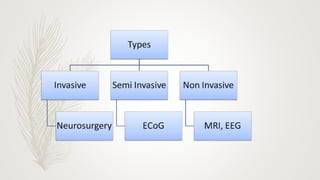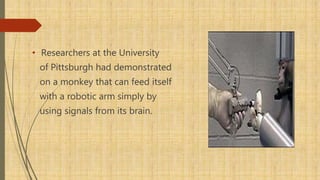brain computing interfaces
- 1. BRAIN - COMPUTER INTERFACES BY K.L.SAI PRANEETH Cherbrolu engineering college
- 2. CONTENTS What is Brain-Computer Interface? History Principle behind BCI Objective of BCI Types of BCIs Conclusion References Brain-Computer Interface
- 4. DEFINITION A brain–computer interface (BCI), sometimes called a direct neural interface or a brain– machine interface, is a direct communication pathway between a brain and an external device.
- 5. Brain Computer Interface is defined as a direct pathway between a human brain and an external device whose actions are controlled by the brain it is connected to. Brain Computer Interfaces are also called as Brain Machine Interface or Direct Brain Machine Interface.
- 6. HISTORY: Research on BCIs has been going on for more than 20 years, but from the mid-1990s there has been a dramatic increase in working experimental implants. Many experiments were performed before releasing BCI into society and for demonstrating the use of BCI and its implementation it was practice on monkeys and rats.
- 7. wHY BCI????? o BCI is a new neuroscience paradigm that might help us better understand how the human brain works. o BCI research allows us to develop a new class of bioengineering control devices and robots. o BCI hold promise for rehabilitation and improving performance. o BCI can expand possibilities for advanced human computer interfaces (HCIs).
- 9. TYPES OF BCI: Invasive BCI Invasive BCIs are implanted directly into the grey matter of the brain during neurosurgery. Partially Invasive BCI Partially invasive BCI devices are implanted inside the skull but rest outside the brain rather than within the grey matter Non Invasive BCI Non-Invasive BCIs do not involve neurosurgery. They are just like wearable virtual reality devices.
- 10. WORKING: The working of BCI can be explained with the following flowchart-
- 12. Structure of a BCI
- 13. Objective of BCI: The goal of the Brain-Computer Interface is to develop a fast and reliable connection between the brain of a severely disabled person and a personal computer . The ‘Brain Gate’ device can provide paralysed or motor-impaired patients a mode of communication through the translation of thought into direct computer control.Brain-Computer Interface
- 14. APPLICATIONS BCI EAR CHIP VISION USING BCI CONTROLLING OF VIDEO GAME BY THOUGHTS IS POSSIBLE USING BCI HONDA’S BRAIN MACHINE INTERFACE CONTROLLING ROBOTS BY THOUGHTS
- 15. BCI Research On Animals: At first, rats were implanted with BCI . Signals recorded from the cerebral cortex of rat operate BCI to carry out the movement. Brain-Computer Interface
- 16. • Researchers at the University of Pittsburgh had demonstrated on a monkey that can feed itself with a robotic arm simply by using signals from its brain.
- 17. Since there was no complication… Next Step- HUMANS!! Brain-Computer Interface 17
- 18. BCI On HUMANS In December 7, 2004, brain-computer interface had been clinically tested on a human by an American biotech company Cyberkinetics. The first participant in these trials was a 25-year-old man who had sustained a spinal cord injury leading to paralysis in all four limbs . Brain-Computer Interface
- 19. BCI INPUT AND OUTPUT
- 20. Controllling of robots using brain computing
- 22. Bcl helps handicapped person To control Robictic hand like Human hand
- 23. WHEELCHAIR ARM CONTROLLED BY THOUGHT ALONE
- 24. BCI IN AVATAR
- 27. Allow paralyzed people to control prosthetic limbs with their mind Transmit visual images to the mind of a blind person, allowing them to see Transmit auditory data to the mind of a deaf person, allowing them to hear Allow gamers to control video games with their minds Allow a mute person to have their thoughts displayed and spoken by a computer
- 28. 1.Virus attacks may occur to brain causing ill effects. 2.Requires extensive training. 3.BCI techniques are costly. 4.Slow speed.
- 29. GAMING Gaming control using a wearable and wireless EEG-based brain- computer interface device with novel dry foam-based sensors.
- 30. Conclusion The results of BCI are spectacular and almost unbelievable. BCI can help paralyzed people to move by controlling their own electric wheelchairs, to communicate by using e-mail and Internet-based phone systems, and to be independent by controlling items such as televisions and electrical appliances. Conclusively, BCI has proved to be a boon for paralyzed patients .
- 31. CONCLUSION: BCI is the most unexpected and unimagined invention of latest technology . This invention helped many disabled people to overcome their disabilities and lead a normal life . People suffering with depression and anxiety have also been benefitted from this invention . Even though BCI has limitations , research is being done at rocket speed in this field and by 2020 BCI will make a pathway to VIRUTAL REALITY.
- 32. BRAIN-COMPUTER INTERFACE 32 Limitations At present ,the biggest impediment of BCI technology is the lack of sensor modality that provides safe, accurate, and robust access to brain signals. It is very expensive. • Information transformation rate is limited to 20 bits/min. • Difficulty in adaptation and learning.
- 34. 34 YOU

































